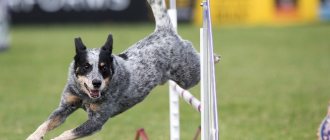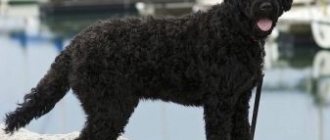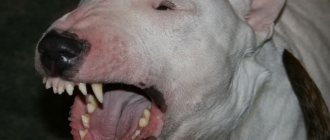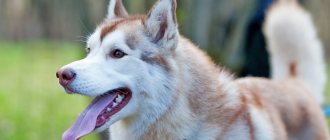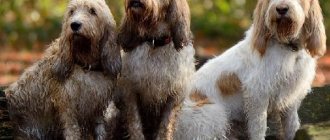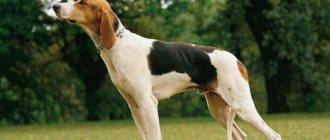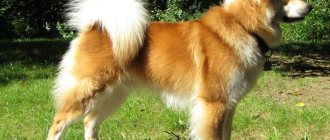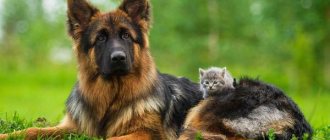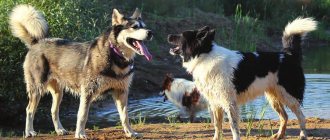Short story
The oldest breed of dogs was formed over a long period of time in the harsh conditions of the Russian North. The Samoyed group of tribes settled in the circumpolar regions approximately 4 millennia ago. Nomads who came from the south of Siberia and the Urals, herding deer in the vast expanses of the tundra, became the ancestors of most modern indigenous peoples (Nenets, Enets, Selkups).
From evidence preserved in the ancient Samoyed language, it turned out that already 3 thousand years ago, white fluffy dogs lived side by side with people. The harsh climate and territorial remoteness made it possible to preserve the breed unchanged for a long time (although people did not strive for this).
Most northern tribes used dogs of the same type, which means that many centuries ago people domesticated white wolves, which became the ancestors of Samoyed dogs. Animals were actively used to transport goods over long distances.
They helped people hunt large animals (bears, walruses) and herd herds of deer. On frosty nights, dogs slept with people, warming them with warm fur. Thanks to their patient disposition and responsible attitude towards their duties, they left small children with them without fear.
Researchers from Siberia and the Russian polar zone drew attention to the attractive and hardy animals during their expeditions. The exact version about the ancestors of the modern breed has not been preserved.
There is an opinion that at the turn of the 19th-20th centuries Samoyeds were bred from Nenets Laikas brought from Yamal (among them there are many white individuals). But the generally accepted version of the origin says that the European line came from three animals brought to Great Britain at the end of the 19th century by zoologist E. Kilburn-Scott.
From the first expedition with the researcher to England, a brown male named Sobaka, a white dog named Masti (from the Siberian tribes) and a cream-colored female Whiteley Pechora (from the west of the Urals) arrived.
In 1909, the Samoyed Club was opened in England by Kilburn-Scott and the standard was written down. The charming dog was quickly appreciated by breeders from other countries. The world owes the preservation of the breed and its development to the British. At home, in Russia, it is still only gaining popularity.
Expert opinion
Anna Abramenko
An avid dog lover. Experience in veterinary medicine since 2009.
Ask a Question
In the 1930s, after the Revolution, the number of northern peoples decreased sharply, and with them dogs almost disappeared. Today it is almost impossible to meet a purebred Samoyed preserved in its natural habitat.
History of the breed
The history of the origin of these dogs began about three thousand years ago, when the first cross between a dog and a white wolf appeared. The Far North, the birthplace of the breed, has a harsh climate. Samoyed dogs are fully adapted to living in low temperatures.
Local tribes, the Samoyeds, entrusted unpretentious dogs with the duties of shepherds of reindeer herds, hunters, watchmen and, most importantly, the driving force for sleds.
Centuries passed, and nothing changed in the life of the Samoyeds and Samoyeds. Herds of reindeer were still grazing, fish were being caught, and dog sleds were racing across the snowy expanses.
At the very end of the 19th century, the English zoologist Ernst Kilburn-Scott, returning home from a trip to the northern regions of Russia, brought home three Samoyed dogs. And in 1909 he opened the Farmingham nursery, which still exists today. Two years later, the first club of breed lovers in Europe was created, and the Samoyed dog standard was adopted.
The British liked the smiling northern pets. The nursery’s capabilities were not enough to provide unique four-legged friends to everyone. In the 1930s, specialized nurseries opened throughout Europe.
In Russia, the fate of the breed turned out differently. Industrialization and the flow of immigrants, the opening of plants, factories, the formation of fishing cooperatives and state farms played a bad joke on the representatives of the breed. The settlers brought with them various companions - from the yard Tuzik to elite greyhounds. People busy building communism did not pay attention to the purity of the local breed. What is a Samoyed compared to the world revolution?
Now there are practically no purebred Samoyeds left in the Far North. Russian breeders bring breeding representatives of the breed from Europe.
Why is the breed called this?
Samoyed is a collective name for the peoples who live in the northern latitudes of Russia. The name of the breed presumably comes from the phrase in the ancient Samoyed language “same-edne” (or “land of the Sami”).
Since breeders discovered future purebred dogs in these tribes, the origin of the name is obvious - the animals were named by analogy with the first owners.
Versions of the origin of the name of the breed
In addition to the most common version of the appearance of the name of the breed, there are other opinions as to why the Samoyed breed is called that way:
- The Samoyed tribes are the only ones who harnessed dogs rather than reindeer to sleds. Due to the white color of the animals, indistinguishable in the snow, people who did not know about this breed thought that the cart drove through the snow on its own. Therefore, the sled teams were called “samoyeds” or “samoyeds,” and later the same name extended to sled dogs.
- Some peoples of the Samoyed group, for example, the Enets, were forbidden to use dogs as a driving force; they moved on reindeer sleds or on skis. The sight of a person skiing on snow alone could also give the entire tribe and their pets the name "Samoyed".
- There is another version why Samoyed dogs were named that way. The very name of the breed, according to some experts, comes from the phrase “same-edne”, which in the language of the ancient Samoyeds meant “land inhabited by the Sami” (the Sami are a small northern ethnic group that lives in Russia, Finland and Norway).
Note! The Samoyed Laika is a primitive (that is, retaining the features of primitive dogs) breed. Even 3000 years ago, she was a companion, warmer, nanny, and “transport force” of the peoples of the Far North.
Samoyeds are companion dogs that perfectly understand their owner’s mood.
Description and standard
The classification places Samoyeds in the same group with Spitz dogs and in the section of northern sled dogs. When running, these animals push powerfully off the ground with their hind legs. Medium size, strong build. At the same time, Samoyeds are light, elegant and graceful.
Adult dog sizes:
- a male weighs between 25-30 kg and grows to 51-56 cm at the withers;
- An adult female has a mass of 17-25 kg and a height of 46-51 cm.
Body proportions: length slightly greater than height, wide and deep chest, strong paws.
Head
The head is wedge-shaped, large, covered with short hair. Stop is expressed.
The breed is divided into 3 types, depending on the shape of the skull:
- bear - the head and ears are rounded, the muzzle is short;
- wolf - the type is similar to the previous one, but the nose is elongated;
- fox - small head, sharp muzzle and ears.
The length of the facial and upper parts of the skull are the same. The eyes are set deep, widely spaced, slightly slanted. The incision is almond-shaped. The color of the iris is dark (brown). Eyelids with black rim.
The distance between the ears is large. The shells themselves are triangular, small, and the cartilage is thick. The nose is only black (in winter it sometimes becomes discolored, but the edging remains). Cheekbones are weakly expressed.
The lips are closed tightly, black. Scissor bite, teeth white and strong.
Expert opinion
Anna Abramenko
An avid dog lover. Experience in veterinary medicine since 2009.
Ask a Question
The limbs are muscular, widely set, straight. The shoulder blades and pasterns are sloped, the shoulders are close to the body. The paws are oval-shaped, the toes are long (protective fur grows between them).
Body type
The neck is medium, with a slight graceful curve. The body is compact. The withers are pronounced.
The back is straight, its length in females is slightly longer than in males. The lower back is narrowed. The croup is wide and has a slight slope. The chest reaches to the elbows. The ribs are round and elastic.
Tail
The tail is set high and carried over the back or side when moving. When at rest it hangs down.
Wool
Samoyeds have long, dense, lush, thick, sparkling hair. It needs to be carefully looked after. Consists of undercoat and a longer, stiffer coat. A “collar” is formed on the shoulders and neck. On the head and limbs the hair length is short. The hair on the outside of the ears is short and smooth, with a good edge on the inside.
The tail and back of the thighs are abundantly covered with thick hair.
Color
According to the standard, three colors are allowed: pure white, biscuit or cream. The main background is always white; there may be a small number of markings on the body.
Any deviations from the listed standards are shortcomings of the breed.
But there are also disqualifying vices:
- multi-colored or blue eyes;
- undershot, undershot;
- excessive timidity or aggression;
- brown or red color;
- floppy ears.
Such individuals are not allowed for breeding or participation in exhibitions.
Features of the Samoyed Laika
The Samoyed is an elegant and confident dog. The dog loves to bark and is considered one of the most “talkative” breeds. Under the soft and thick snow-white fur hides a well-developed dog, medium in size with good muscles and excellent endurance. At the same time, the dog has a gentle character and adores its owner.
The unusual face is remembered for its smile. The corners of the dog's mouth are slightly raised, and the eyes have a sly squint.
Samoyed Spitz can have a different head structure. Based on this characteristic, the breed is divided into three types:
- Bear type. The head is more round in shape, the ears are small round in shape, and the muzzle is short.
- Fox type. The head is light with a sharp and long muzzle, like a Spitz. The ears are pointed and set high.
- Wolf type. The skull is powerful, but the muzzle is more elongated than that of the bear type.
A dog of any type has an easy-going character and developed intelligence. The Samoyed will become a true friend for a person at any age.
Varieties
The first breeder in history, E. Kilburn-Scott, divided his pets according to head shape into fox, wolf and bear types. Unofficially, Samoyeds are still classified this way. There are no other types of the breed.
This is interesting: Popular breeds of bear dogs
Dwarf or mini Samoyeds are common deviations from the standard.
Initially, Samoyeds living in nomadic tribes had quite different colors - black, spotted, brown, beige. Pure white became the standard as a result of the breeding work of early breeders.
Character and appearance
Samoyeds are not timid, but they are absolutely not aggressive. They clearly express social behavior. They feel great in the company of people and other animals, they are friendly and cheerful.
They are not wary of strangers and always make contact, which is why they are not good guards. Hunting instincts are weakly expressed (this is a big plus - there will be no encroachments on other domestic animals).
Dogs often show disobedience and stubbornness, and are mischievous. They willingly participate in all family activities and love to relax next to their owners on the sofa. From loneliness they become depressed or start acting out.
Their character is independent, patient, and understanding. Intelligence is high. The pack instinct is developed, so they get along in the company of other dogs. The relationship between the Samoyed and children of any age will be wonderful.
The appearance of the animals is very impressive. They are harmonious, charming and beautiful. And this often becomes the reason for a rash choice of a pet that is difficult to keep.
Health of modern Samoyeds
Since the Samoyed is indigenously bred, it can be considered a potentially healthy dog. Like all Spitz dogs, Samoyeds are prone to hip dysplasia and age-related retinal atrophy. Modern veterinary medicine makes it possible to check the genetic predisposition to the above diseases through DNA testing.
A separate problem of the Samoyed Laika is allergies. Since the allergic reaction causes itching, the dog's appearance is the first to suffer. Under thick, padded fur, the skin constantly gets wet, which leads to the formation of eczema and the growth of the affected area.
Education and training
Samoyeds, especially at an early age, are not very obedient; training can be a problem at first. For training to be effective, it is necessary to show rigor and introduce variety. Dogs are responsive to praise and encouragement. The right approach will greatly simplify your studies.
You cannot suppress the will of the Samoyed, otherwise he will be stubborn in the future. If you choose the optimal training process from the first months, the dog will quickly become obedient and controllable.
Disobedience and self-will must be nipped in the bud, otherwise a smart Samoyed will immediately sense the weakness and show character. Misdemeanors should be punished, but not too harshly and only fairly.
The pet must immediately recognize the leader in the owner, otherwise the teenager, and then the adult dog, will begin to dominate the family.
Expert opinion
Anna Abramenko
An avid dog lover. Experience in veterinary medicine since 2009.
Ask a Question
In order for living conditions to ideally match the characteristics of the breed, you need to have a country house. Samoyeds are bad guards, so there is no point in putting them in an enclosure or on a chain (this is harmful to the psyche).
Raw meat
Compared to cannibalism, the Nenets' predilection for eating raw meat and fish does not seem so horrifying, but, nevertheless, it is an atypical way of eating food.
In the calendar period from May to mid-August, when the harsh winter in the habitats of the Nenets gives way to a relatively mild off-season, it is time to slaughter reindeer raised for food.
At the same time, Nenets, young and old, can enjoy their favorite national dish - raw venison. Killed by a skillful blow of a knife to the heart, the deer is placed on an improvised table, and each participant in the meal cuts off a piece of meat, dips it in warm blood and savors his favorite dish with appetite.
In addition to elk meat, the Nenets happily eat its raw liver and kidneys, bone marrow and windpipe, lower lip and tongue, abomasum and heart, which are considered delicacies and if there is a guest in the community, these parts are hospitably presented to him.
A special treat is pancakes mixed with reindeer blood, which the Nenets actively use in fresh and frozen form.
By the way, the Nenets’ love for raw, bloody meat is explained not only by cultural traditions, but also by the body’s basic need for nutrients and vitamins C and B2, which are found in large quantities in venison.
This delicacy allows northerners not to suffer from scurvy and charges the body with the energy necessary to survive in extremely difficult natural conditions.
In winter, the place of fresh meat is taken by frozen venison, which is served in the form of thinly sliced shavings, known as stroganina. The same name is given to a dish of heavily frozen fish that the Nenets prepare on holidays. On weekdays, they prefer stroganin to “beater,” an extremely frozen fish that breaks into edible fragments when it hits a hard object.
In addition, the Nenets eat seal meat and bear meat soaked in water, but do not eat seagulls, which they consider sacred birds, and do not eat mushrooms, since they serve as food for deer.
Care and maintenance of the Samoyed
You should not purchase a puppy earlier than 1.5-2 months of age. And you immediately need to provide the baby with optimal conditions. A private house with a spacious yard is best suited.
If the dog is kept in an apartment, then it will need to organize daily long walks with physical activity (jogging, active ball games, etc.). Regular communication with the owner is necessary; Samoyeds do not tolerate prolonged loneliness.
These dogs do not survive the heat well. They are prone to digging holes in the area, especially in the summer, they remove the heated layer of soil and lie down in a hole.
Traditional rules of care:
- The dog does not have a characteristic odor, its fur is self-cleaning, so the pet should be washed no more than once every 3 months with special products. Frequent bathing with shampoo will make the coat dull.
- Eyes and ears are wiped 2 times a week with a wet cloth.
- Pets are given a personal sleeping area in a cool place, as they are extremely sensitive to overheating.
- Samoyed fur requires careful care. Without weekly brushing, there will be a lot of hair in the apartment, and the dog will take on an unkempt appearance. During shedding, you will have to comb out the fluff every other day.
- Teeth are freed from plaque and stone with raw vegetables, store-bought bones, and cartilage. Cleaning is enough once a week.
- During hot weather, it is advisable to install a bathtub or pool of water in the yard so that the dog can cool down.
Samoyeds are quite difficult to keep and require a lot of attention and love.
Content
Due to its rich coat, the Samoyed dog does not tolerate apartment living well. The best option for them would be a spacious courtyard of a private house. A dog can live well in an enclosure if given regular active walks, but life on a chain is not an option for them.
Need for physical activity
Samoyeds are active, energetic dogs that need constant physical activity, like all huskies. In apartment living conditions, this problem is quite acute. Due to unspent energy, the Samoyed dog will be prone to constant howling, self-indulgence, and tearing wallpaper and furniture. If in megacities there is no place to walk dogs or let them off the leash so that they can run around, then special fitness rooms can be a solution to the problem. You can also go cycling.
There are much fewer problems when maintaining outside the city. Living on a spacious plot, the dog can run around the yard to his heart's content. But several long walks a week outside the fence must be included in the dog’s exercise routine.
Pregnant bitches deserve special attention. In the second half of pregnancy, active walks should become calm, and it is better to eliminate physical activity altogether.
Appearance care
Samoyeds have a delightfully rich coat, but they are one of the few breeds that do not require specific grooming.
It is necessary to comb your pet well a couple of times a week, and during the period of active shedding this will have to be done daily.
How to comb out correctly:
- First, go through with a brush, cleaning the contaminated areas;
- Next, use a slicker brush to comb through the undercoat;
- You can only comb in the direction of hair growth;
- By running your hand against the fur, you will noticeably fluff up the undercoat.
The coat cleans itself perfectly on its own, so you can bathe your dog no more than 3-4 times a year. Exhibition animals are washed much more often, but professional cosmetics are used for this.
Nutrition
This breed is absolutely unpretentious in terms of nutrition. They eat perfectly prepared dry food and natural food. When choosing dry food, you should carefully choose the composition. After all, dogs have snow-white fur, which can become colored if carrots, beets and other coloring ingredients are present in the food.
It is not recommended to combine natural food and industrial feed together.
Proper nutrition
The owner independently determines the puppy’s diet. When purchasing, it is important to find out what the small dog was fed by the breeder. And then either leave the feeding the same, or gradually transfer her to a new food.
Dry food is required with a high protein content (holistic), or super-premium from a trusted manufacturer.
This is a Useful article: Proven premium food - 2021 rating
The following products should be included in a natural diet:
- at least 30% lean meat (lightly cooked);
- cereals (rice, buckwheat);
- meat;
- sea fish;
- vegetables fruits;
- cottage cheese, kefir.
Completely exclude bones, fatty meats, sweets, baked goods, white bread, potatoes, and beets from the diet. Give limited amounts of pasta, milk, and carrots.
From 1.5-2 to 4 months, meals are 4-5 times a day, then the number of feedings is reduced to 3, by one year - to 2.
Health and treatment
The breed was formed naturally, so it has endurance and good health.
Common dog ailments:
- diabetes;
- arthritis;
- joint dysplasia;
- digestive problems;
- genitourinary infections;
- allergies occur periodically;
- rare congenital pathologies - deafness and eye diseases.
The pet's health must be kept under control: vaccinations should be done on time, and regular visits to the veterinarian for examinations should be carried out. If a disease occurs, do not self-medicate, but immediately go to the clinic.
Features of care
The most difficult thing in caring for this gorgeous “snow white” is, of course, its fur. The fact that there is an indelible effect on those around us forces houses to be constantly cleaned and cleaned. Therefore, if you are not going to conquer exhibition centers with your ward, then the best way out of this situation is to get a haircut. There is nothing scary about this, especially if you trust the professionals. A neat hairstyle will in no way negatively affect the natural charm and visual appeal of your pet. And it will make your life much easier. The rest of the move is completely standard. It is recommended to select food together with a veterinarian.
Pros and cons of the breed
The Samoyed's charming appearance often becomes a reason to rashly purchase a dog as an apartment pet. To find out whether the family is ready for such a companion, it is necessary to carefully study the care and maintenance requirements.
Advantages of the breed:
- cheerful, loyal character;
- beautiful appearance;
- no unpleasant odor;
- reverent attitude towards children;
- getting along with other animals.
Obvious disadvantages of the breed:
- beautiful coat requires constant care;
- an energetic dog needs an active lifestyle;
- the animal is not suitable for the role of a guard;
- it loves to bark and howl. This behavior can be somewhat corrected with proper training, but a dog that is bored or has been alone for a long time will most likely begin to vocalize.
List of suitable nicknames
When choosing a name for a puppy, follow a few simple rules. The character traits or external signs of the pet are taken as a basis. It is better if the nickname is short (1-2 syllables) and easy to pronounce.
Options for boys:
- Ice, Archie, Arthur, Altai, Agate;
- Bike, Baikal, Bart, Boy, Butch;
- Wulf, Volt, Jack;
- Thunder, Huron, Dick, Watch, Jack, Friend, Zeus;
- Irtysh, Kai, Leo, Loki;
- Marat, Ostap, Prince, Ralph, Rex;
- Frost, Nord, Nils, Scooby, Snowball, Snowdrift;
- Tom, Fog, Umka, Hulk, Charlie, Chip;
- Elf, Ace, Yukon, Yang.
Options for girls:
- Alba, Alpha, Astra;
- Storm, Bonnie, Blizzard, Thunderstorm, Greta;
- Dina, Dora, Gina;
- Winter, Zoya, Kara, Clara, Kira;
- Linda, Lada, Lucy, Molly, Monica, Martha, Mary, Mukha;
- Nora, Nyusha, Polina, Snezhka, Sofia, Sarah;
- Uma, Fiona; Chapa, Ellie, Utah, Yara.
Education is of primary importance in shaping a dog’s character, but it is believed that a nickname can also influence its character and destiny.
Selection rules
A good (and expensive) puppy must fully comply with the description of the breed in the standard and have ideal innate characteristics. Upon purchase, owners are given a veterinary passport with vaccination marks and an RKF card (it is subsequently exchanged for a pedigree).
This is interesting: TOP 10 most expensive dogs in the world
The baby must be kept in good conditions, have no hereditary pathologies and be active and healthy in appearance. The type of breeding for future champions is only linear!
Expert opinion
Anna Abramenko
An avid dog lover. Experience in veterinary medicine since 2009.
Ask a Question
Before purchasing, it won’t hurt to get to know the representatives of the breed closely. You can ask the owner about the difficulties of keeping it. Love and loyalty to the family are guaranteed, but you need to prepare for life under the same roof with an unusual dog in advance.
Bird beak toys
The antlers and beaks of killed birds shed by deer are the only toys of Nenets children, who are not even aware of the existence of teddy bears, transforming robots and all kinds of barbies.
From a very early age, Nenets boys, introduced to the traditional way of life, run around with deer antlers, pretending to race, and by the age of 7 they already know how to prepare a harness, ride a sled and lasso tame elk.
Girls at this age are allowed to do exclusively female tasks, that is, lighting a fire, preparing water and brushwood, as well as sewing. During breaks between work, they play with the traditional Nenets doll “nuhuko”, the head of which is made from the beak of a goose or duck, and the body is made of scraps of colored cloth.
In order to create a doll family, girls are given “nuhuko” of both sexes: a toy with a goose’s beak represents a man, and a toy with a duck’s beak represents a woman.
Samoyed cost
The price of puppies ranges from 12 to 55 thousand rubles. The difference depends on the nursery, producers and region.
The most valuable are those intended for sports (skijoring, bikejoring, cani-cross, etc.). Sled dog racing has gained enormous momentum all over the world, so there is always an increased demand (and even a waiting list) for promising offspring from working parents.
Adult champions and prize-winners of exhibitions are sold for much more - 100 thousand rubles and more.
Puppy cost
I would immediately like to warn against the desire to save money and buy a puppy from home-grown breeders. You risk bringing into your home an animal with psychological and physical disabilities, since you have no idea about the genes embedded in it. It is better to save some money and contact an official and specialized nursery.
A puppy for a family can be purchased for a price ranging from ten to twenty-five thousand. They may have a small defect that is unacceptable by breed standards, but this defect will not affect their companion qualities in any way. The next category allows you to use your pet for breeding. The cost will increase to thirty-five thousand. Well, if a stellar pedigree is important to you and you intend to make a real champion out of your ward, then the price will soar to sixty thousand rubles.
Nurseries
In Russia, the breed is just gaining popularity, and there are still few reliable nurseries breeding Samoyeds. Therefore, the cost of a puppy suitable for professional sledding is quite high.
If a dog is purchased as a companion, for home keeping, then when purchasing a dog, future owners should pay attention to the reputation of the breeder (or kennel), get acquainted with the manufacturers and their documents.
Samoyed photo
In the photo, the Samoyed has a standard white color, with fluffy and thick hair.
In the photo we managed to capture the traditional “Samoyed smile”, which makes the dog’s facial expression even more intelligent and cute.
Puppies are more like plush toys.
Interesting facts about the breed
Many interesting facts are known from the long history of the dog’s existence:
- The northern peoples of Russia adapted Samoyeds for carrying heavy loads, but extremely rarely used them for sled riding. Deer were more suitable for this.
- Calling a dog a “Lika Samoyed” is incorrect. However, this version of the name of the breed can be heard quite often.
- The famous writer Jack London once said that this is the most beautiful dog in the world.
- Explorer R. Amudsen was the first to reach the South Pole on a sled with Samoyeds. The breed was incredibly popular in polar expeditions in those days.
- Sometimes you can hear such an erroneous name as “Samoyed Shepherd”.
- Samoyeds, along with Huskies, Chinooks, Malamutes and some other breeds, are leaders in sled dog breeding. A team can cover 50-60 km per day at a speed of 10-12 km per hour.
Due to some external similarity, Samoyeds are called “Arctic Spitz”, although the only thing the two breeds have in common is that they are in the same group of canine classification.
Character
Samoyeds have a cheerful, positive disposition. They easily find contact and a common language with all family members. However, a little willfulness and independence are still present in their blood. Therefore, loneliness is not so scary for them, because they can easily have fun on their own. True, whether the owners will like their entertainment is, of course, questionable...
Samoyed dogs are not prone to aggression. They will greet a stranger with a loud bark, but only to notify the owners of the visit.
They get along well with children and other pets. Samoyeds do not tend to be dominant or jealous of anyone.
For a long time, Samoyeds have been used in harness with other relatives, which is why they can find a common language with them. Their hunting instinct is poorly developed, so early socialization and education can contribute to friendly cohabitation even with cats.
Despite the open attitude towards all household members, only one person will be the real owner. This will be a real choice of a dog’s heart, to which the pet will remain faithful until the end of its life.
Reviews
“We bought a Samoyed solely because of its beautiful appearance and good-natured character. Many other qualities were pleasant surprises: the dog smells almost nothing, eats well and does not suffer from allergies, and during routine cleaning of the apartment there is almost no hair or fluff. The dog picks up commands on the fly and is very obedient. I recommend to all".
“I don’t regret at all that I bought a Samoyed at the time. Jack understands me perfectly, is very attentive and responsive, although he likes to be cunning a little. But I can say for sure: this breed is not for lazy people. It is imperative to regularly groom the dog’s coat, take long walks and pay attention to the dog.”
“I love my Samoyed girl very much. I chose it after much thought, but now I understand that this is not the best option for living in an apartment. The dog needs frequent active walks, which are much easier to organize in a private home. It takes a lot of time. Otherwise, the breed is ideal for a family.”
Owner reviews
From the variety of reviews about these amazing beauties, we present the most characteristic ones:
- “The dog is ideal for those people who lead an active lifestyle and are ready to pay great attention to the Samoyed! Otherwise, out of boredom, they will begin to chew the wallpaper and generally go crazy”;
- “Attentive and sensitive! She always greets you and wags her tail, she may ask you to leave the ball, but she is not annoying. Not suitable for those who do not want to bother with a dog - Samoyeds have many pedigree diseases...”
In conclusion, we can say that the dog is ideal for families and for active people who do not like a sedentary home lifestyle. This is the cutest dog breed, included in the unofficial Top 10 most beautiful, it is literally “white and fluffy”.
Additionally, check out the video for a detailed description of the Samoyed breed:


